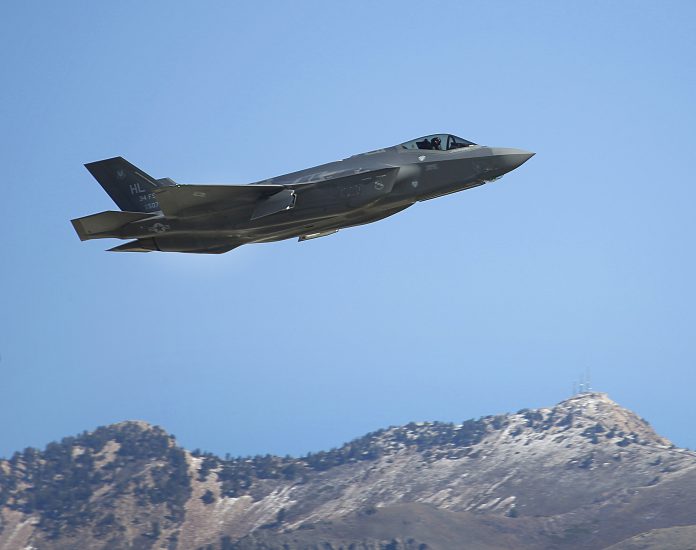
U.S. Air Force bombers flew over international waters east of North Korea as tension simmers between the two nations and their respective leaders, and a tremor earlier struck close to North Korea’s nuclear test site.
The U.S. B-1B Lancer bombers, based in Guam, and F-15C Eagle fighter escorts from Okinawa, Japan, flew the farthest north of the Demilitarized Zone, or DMZ, any U.S. fighter or bomber aircraft have flown off North Korea’s coast in the 21st century, Dana White, the chief Pentagon spokeswoman, said in an emailed statement.
The exercises were meant to underscore “the seriousness with which we take DPRK’s reckless behavior,” White said, using an acronym for North Korea. “This mission is a demonstration of U.S. resolve and a clear message that the President has many military options.”
The DMZ is a strip of land that has divided South Korea and North Korea since 1953.
The tremor occurred at 4:29 p.m. China time with a magnitude of 3.4 and a depth of zero kilometers, the China Earthquake Networks Center said in a statement. South Korea’s weather agency said in a statement on its website that it was not artificially triggered.
The United States Geological Survey put the quake’s magnitude at 3.5 and its depth at 5 kilometers (3.1 miles). On its website, the USGS said that it “cannot conclusively confirm at this time the nature (natural or human-made) of the event.”
North Korea detonated its sixth and most powerful nuclear weapon earlier this month at its underground Punggye-ri site northeast of Pyongyang, causing a quake with a magnitude of around 6.3. The move escalated tensions with the U.S. and North Korea’s neighbors, and this week its foreign minister said the regime’s options included testing a hydrogen bomb in the Pacific Ocean.
There have been concerns about the stability of the nuclear test site since the September 3 detonation. Website 38 North said satellite imagery taken after that test appeared to show landslides atop the site that were more numerous and widespread than after the previous five tests.
The website, run by the U.S.-Korea Institute at Johns Hopkins University’s School of Advanced International Studies, added the bomb’s 250-kiloton yield was close to what it previously determined was the maximum that could be contained by the test site.
The September 3 detonation followed two intercontinental ballistic missile launches in July that brought Kim Jong Un’s isolated regime a step closer to achieving its aim of being able to deploy a nuclear warhead over the continental U.S.
On Thursday, North Korea struck back at President Donald Trump’s threats to destroy it, with Kim warning of the “highest level of hard-line countermeasure in history” and his foreign minister suggesting that could include testing a hydrogen bomb in the Pacific Ocean.
Foreign Minister Ri Yong Ho spoke to reporters in New York, where he is attending the United Nations General Assembly and is scheduled to speak on Saturday. He said in remarks broadcast on South Korean TV that the countermeasures flagged by Kim might refer to a “strongest-ever” ground-level test of a hydrogen bomb in the Pacific.
His comments came after Trump ordered new sanctions on individuals, companies and banks doing business with North Korea as he sought to further isolate the regime and increase economic pressure for it to curb its weapons programs.
North Korea’s state media issued a statement Saturday from the National Peace Committee of Korea describing Trump as “wicked” and “a rabid dog.”
“He, who cried out the extermination of the Korean nation, is a blood-thirsty beast indulged in massacring,” the Korean Central News Agency cited the statement as saying. “It is necessary not to make Trump, a source of the world’s worst misfortune, survive to run amok and not to make the U.S. exist on this planet as it only inflicts untold suffering and misfortune upon the Korean nation and humankind.”
Earlier this month, Pyongyang fired its second missile in as many months over northern Japan into the Pacific Ocean. Since Kim came to power after the death of his father Kim Jong Il in 2011, he has ramped up nuclear and missile weapon tests.
U.S. analysts now estimate that North Korea may have as many as 60 nuclear weapons, according to a Washington Post report. That’s in addition to cyberwarfare capabilities, a biological weapons research program and a chemical weapons stockpile. It also has a vast array of conventional artillery aimed at Seoul.
(c) 2017, Bloomberg News · Janet Ong, Sam Kim
{Matzav.com}











